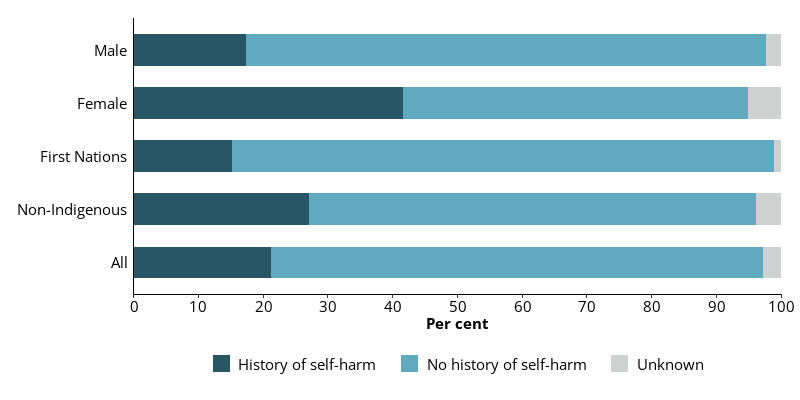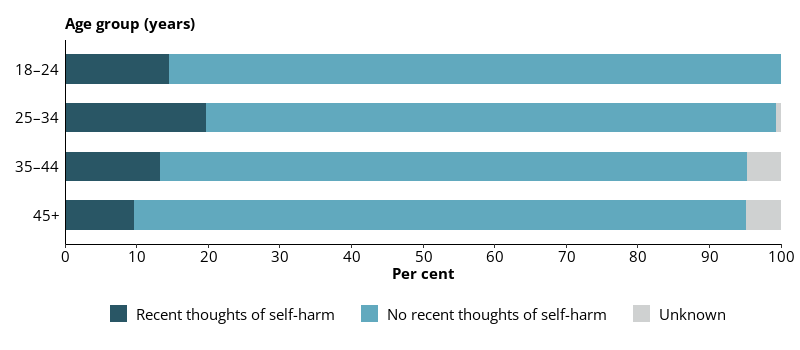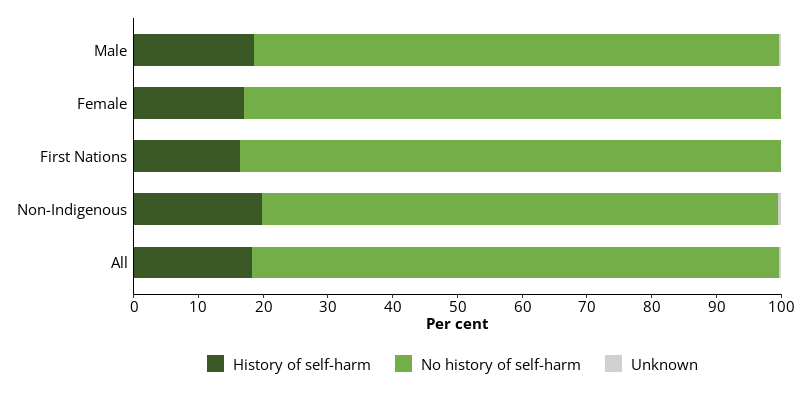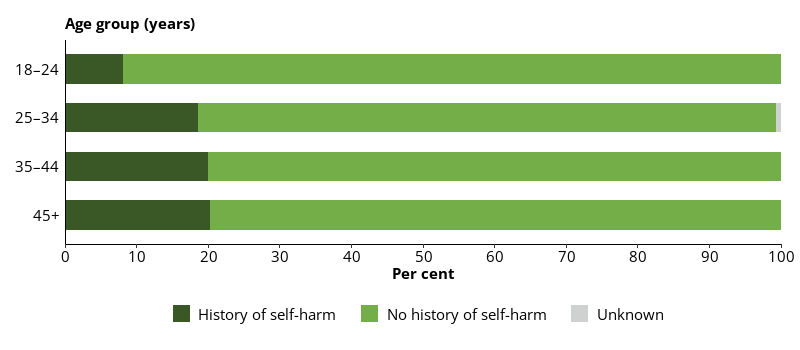Self-harm
Self-harm is a broad term that refers to a person intentionally inflicting physical harm to their own body, an act that may or may not have been intended to cause death (AIHW 2022).
Rates of self-harm and suicide in Australia differ between males and females. Crude rates of suicide rates in Australia were more than 3 times greater for males (19 per 100,000) than females (6 per 100,000) in 2019–20 (AIHW 2022).
Suicide rates were higher for:
- males than for females
- First Nations Australians than for non-Indigenous Australians
- those who were more socioeconomically disadvantaged.
All of these groups are over-represented in the prison population (AIHW 2022).
A history of self-harm is particularly common in the prison population where risk factors for self-harm – such as a history of childhood abuse, mental health conditions, or alcohol and other drug use disorders – are also more prevalent than in the general population (Barton et al. 2014; Stewart et al. 2018).
A recent study of the health and wellbeing of people in an Australian prison showed that people in prison were 10 times as likely as the general Australian population to report a history of suicide attempts and thoughts of suicide within the previous 12 months (Butler et al. 2018).
Prison entrants' experiences of self-harm
During the data collection period, prison entrants were asked if they:
- had ever intentionally harmed themself
- had thoughts of harming themself in the last 12 months (referred to in this section as recent thoughts of self-harm).
Over 1 in 5 (21%) prison entrants reported a history of self-harm (Indicator 1.4.7).
Female prison entrants (42%) were more than 2 times as likely to report a history of self‑harm as male prison entrants (17%) (Figure 5.10).
Non-Indigenous prison entrants (27%) were more likely to report a history of self-harm than First Nations prison entrants (15%) (Figure 5.10). Prison entrants aged 18–24 (29%) were most likely to report a history of self-harm, and prison entrants aged 45 and over were least likely (15%).
Figure 5.10: Prison entrants, history of self-harm, by sex and Indigenous identity, 2022

Notes:
- Proportions are representative of this data collection only, and not the entire prison population.
- Excludes Victoria, which did not provide data for this item.
Source: Entrants form, 2022 NPHDC.
More than 1 in 7 (15%) prison entrants reported having thoughts of self-harm in the previous 12 months (Indicator 1.4.8).
Female prison entrants (30%) were over 2 times more likely to report recent thoughts of self‑harm than male entrants (13%).
Non-Indigenous prison entrants (17%) were fairly similar to First Nations prison entrants (13%) in reporting recent self-harm thoughts.
Recent thoughts of self-harm were reported most in entrants aged 25–34 (20%), and least in entrants aged 45 and over (9.8%) (Figure 5.11).
Figure 5.11: Prison entrants, thoughts of self-harm in the previous 12 months, by age, 2022

Notes
- Proportions are representative of this data collection only, and not the entire prison population.
- Excludes Victoria, which did not provide data for this item.
Source: Entrants form, 2022 NPHDC.
Identification of self-harm or suicide risk
At the end of the prison entrants’ survey, staff administering the survey were asked if the participant was identified as currently at risk of self-harm or suicide (excluding at 4 prisons in New South Wales where researchers administered surveys).
Participants identified at risk of self-harm or suicide should be supported according to best practice at the prison.
One in 16 (6.3%) prison entrants were identified by staff as being at risk of self-harm or suicide (Indicator 1.4.9).
Female entrants (28%) were 8 times more likely than male entrants (3.6%) to be identified as being at risk of self-harm. Non-Indigenous entrants (6.8%) were similarly as likely to be identified as at risk as First Nations entrants (5.4%).
Prison dischargees experiences of self-harm
Prison dischargees were asked if they had ever intentionally harmed themselves before their current incarceration and if they had intentionally harmed themselves during their current period in prison.
Almost 1 in 5 (18%) prison dischargees reported a history of self-harm before their current incarceration.
Female prison dischargees (17%) were similar to male dischargees (19%) in reporting a history of self-harm. Non-Indigenous prison dischargees (20%) were similarly as likely to report a history of self-harm as First Nations dischargees (17%) (Figure 5.12).
Figure 5.12: Prison dischargees, history of self-harm before current incarceration, by sex and Indigenous identity, 2022

Notes
- Proportions are representative of this data collection only, and not the entire prison population.
- Excludes Victoria, which did not provide data for this item.
Source: Dischargees form, 2022 NPHDC.
The likelihood of prison dischargees reporting a history of self-harm before their current incarceration increased with age – from 1 in 13 (8.2%) prison dischargees aged 18–24 to 1 in 5 (20%) dischargees aged 45 and over (Figure 5.13).
Figure 5.13: Prison dischargees, history of self-harm before current incarceration, by age, 2022

Notes
- Proportions are representative of this data collection only, and not the entire prison population.
- Excludes Victoria, which did not provide data for this item.
Source: Dischargees form, 2022 NPHDC.
The proportion of prison dischargees reporting intentionally harming themselves in prison was lower than those reporting having self-harmed at some stage in their lives.
One in 20 (5.1%) prison dischargees reported having harmed themselves during their current period in prison (Indicator 1.4.10).
Male dischargees were similarly as likely to report intentional self-harm during their current period in prison (5.5%) as female dischargees (3.1%), and non-Indigenous dischargees (6.1%) were similarly as likely to do so as First Nations dischargees (4.0%).
Self-harm while in prison was most reported in prison dischargees aged 25–34 (7.7%) and least reported in dischargees aged 18–24 (2.0%).
AIHW (Australian Institute of Health and Welfare) (2022) Injury in Australia: intentional self-harm and suicide, AIHW website, accessed 1 May 2023.
Barton, J., Meade, T., Cumming, S., and Samuels, A. (2014). Predictors of self-harm in male inmates. Journal of Criminal Psychology, 4(1), 2-18.
Butler A, Young JT, Kinner SA and Borschmann R (2018) ‘Self-harm and suicidal behaviour among incarcerated adults in the Australian Capital Territory’, Health & Justice, 6(1):13, doi:10.1186/s40352–018–0071–8.
Stewart AC, Cossar R, Dietze P, Armstrong G, Curtis M, Kinner SA, Ogloff JRP, Kirwan A and Stoové M (2018) ‘Lifetime prevalence and correlates of self-harm and suicide attempts among male prisoners with histories of injecting drug use’, Health & Justice, 6(1):19, doi:10.1186/s40352–018–0077–2.


